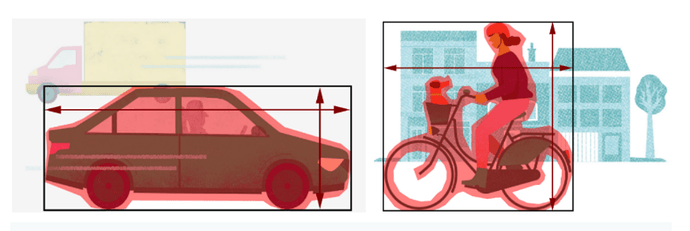Your Telraam sensor gathers a lot of visual data. Classifying all road users and placing them into the correct vehicle type category (pedestrian, cyclist, car or large vehicle) is not an easy task. Here, you can find out how Telraam manages to do just that.
How does Telraam’s classification work?
In simple terms, Telraam’s classification is based on the average fullness and axis ratio of each observed object. These two parameters are distance- and speed-independent, i.e. whether a car drives past the Telraam sensor at a distance of 5 or 10 meters and at a speed of 10 or 80 km/h, it will still have the same values in terms of fullness and axis ratio.
Please note that Telraam uses a set of criteria to filter out any moving objects in the field of view that are considered unlikely to be road users.
Fullness and axis ratio
To have a better grasp of what fullness and axis ratio entail, take a look at the figure above.
Fullness indicates the extent to which the red shaded area covering the car and bicycle fills up the space inside the black rectangle. Observe that the fullness of the car is significantly larger than the fullness of the cyclist (and becomes even more so when looking at these objects from the typical height of a Telraam sensor).
Axis ratio is the ratio of the two arrows (width divided by height). For the cyclist, this ratio is around 1, as the width and height are more or less the same. For the car, this ratio is around 0.5, as the width is twice the height.
Based on fullness and axis ratio, and using an automated method, Telraam classifies each passing road user as either a pedestrian, cyclist, car or large vehicle. To ensure correct classification, this whole system is continuously being finetuned.
If you would like more technical information on Telraam’s classification method, you can click here to download a more detailed description.
Classification issues
In some cases, Telraam does not correctly distinguish between cars and large vehicles (including vans, cars with trailers, pickup trucks, light and heavy trucks, as well as buses). The number of cars can be underestimated and the number of large vehicles overestimated, or vice versa. The sum of both vehicle types, however, is usually correct. We, therefore, ask you to be conscious of the fact that Telraam’s large vehicle count data does not have the same accuracy as the data on cars.
The difference between cyclists and pedestrians is not always straightforward either, especially if several pedestrians or cyclists are riding together. Here, there might be occasional inconsistencies too.
